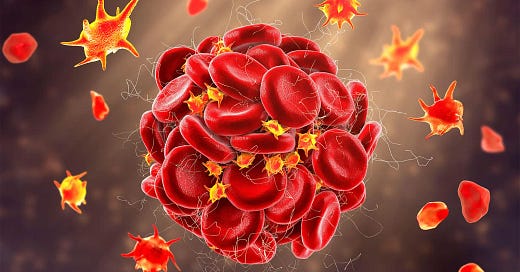Nearly everyone who has seen a doctor or been in a hospital has had their finger put into a simple devise, a pulse oximeter, that measures blood oxygen level. It should be 95% or higher (usually 97% or more) if you are in good health. Various health problems, including respiratory illness can cause reduced blood oxygen level. This is a serious medical problem, because your lungs and organs are not getting sufficient oxygen. Some years ago I bought my own device that is not expensive so I could check my oxygen level at home.
Here are some recent comments by the great Dr. Peter McCullough:
“The past three years have generated millions of case vignettes of patients with COVID-19 respiratory illness. The most dramatic cases include critically ill inpatients with severe hypoxemia despite maximum respiratory support. By far, the most notable cases of survival have occurred with the administration of ivermectin. Former NIH researcher David Scheim, PhD, early in the pandemic proposed that SARS-CoV-2 Spike protein was acting like a grappling hook pulling together circulating red blood cells into long chains and clumps in a process called hemagglutination. This explained why the red blood cells could not carry oxygen normally and was congruent with the finding of micro blood clots in the lungs.”
“In a spectacular publication, Stone et al, describes the prompt improvement of oxygenation in patients with ivermectin. “
“The published oxygenation curves from multiple studies clearly show this physiological effect of ivermectin occurs so rapidly, it must be explained by a direct anti-Spike protein effect of ivermectin. …So for the next critically ill patient with COVID-19, if the opportunity presents itself, push for the administration of ivermectin. This is the only published therapy for COVID-19 that improves oxygen saturation while the patient mounts a recovery. As in this man, it may be the critical factor for a turnaround and a chance to walk out of the hospital. “
Here is the abstract of the new research on ivermectin success in raising blood oxygen:
“The emergence of COVID-19 in March 2020 challenged Zimbabwe to respond with limited medical facilities and therapeutic options. Based on early clinical indications of efficacy for the macrocyclic lactone, Ivermectin (IVM), against COVID-19, IVM-based combination treatments were deployed to treat it. Oxygen saturation (SpO2) data were retrospectively analyzed for 34 severe, hypoxic COVID-19 patients all on room air (without supplemental oxygen). The patients, median age 56.5, were treated at clinics or at home between August 2020 and May 2021. All but three of these 34 patients had significantly increased SpO2 values within 24 h after the first IVM dose. The mean increase in SpO2 as a percentage of full normalization to SpO2 = 97 was 55.1% at +12 h and 62.3% at +24 h after the first IVM dose (paired t-test, p < 0.0000001). These results parallel similar sharp, rapid increases in SpO2, all on room air, for 24 mostly severe COVID-19 patients in the USA (California) who were given an IVM-based combination treatment. All patients in both of these critical series recovered. These rapid increases in SpO2 values after IVM treatment stand in sharp contrast to declines in SpO2 and associated pulmonary function through the second week following the onset of moderate or severe COVID-19 symptoms under standard care.”
In summary, ivermectin acts to prevent and resolve early COVID invection because of its antiviral property. in final stages of severe illness it can cure because of its antiinflammatory property. And now we know that it can remove blood clots that block oxygen flow. But, still, the government does not come out in a very public way to endorse use of ivermectin in the COVID pandemic. Though a federal lawyer has said in a court case that the government has not explicitly or actually blocked its use. So get yourself some ivermectin, available from many companies in India, or convince your own doctor to give you a prescription for it. But sadly most hospitals will probably keep blocking its use for COVID patients.





I caught Covid-19 last April--was tested positive. I awakened that morning with a fever, chills intense body aches, and a deep, hoarse, dry PAINFUL cough. I didn't wait for the test results. I'd purchased a couple of bottles of "pour on" Ivermectin a few months previous "just in case...". Instructions said to apply 10ml to the skin for an animal of my weight. I chose the pour-on formula as I didn't know if I might be allergic to the stuff, and so didn't want the injectable form, nor the "paste" which might upset my stomach. Didn't need to be retching or having diarrhea AND Covid-19. The pour on is applied to the skin--per accompanying instructions--on clear, sunny days, as rain will wash it off of the "patient's" skin, rendering it of no effect. Seemed like the least risky. If I had a reaction, I'd just be able to wash it off with plain water. Because I was treating a viral illness, I applied it to my skin TWICE a day--if you're treating parasites in livestock, it's a one-time treatment, but everything I'd read about it's use in humans as an antiviral suggested multiple treatments. As it worked out, the only reaction was about 8 hours later, when the fever, chills, muscle pains and insanely runny nose had cleared up. The cough, however, hung on. On the 6th day, I was completely well and returned to work, though I continued to apply the stuff for several more days to avoid a relapse. You can buy the stuff in any feedstore for under $30.00. If they ask why you want it, just tell them your uncle said the horse has worms...
Thank you!